insportline Kids Bike KAWASAKI Kasaii User Manual
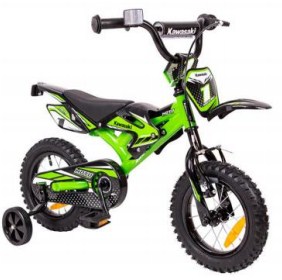
This manual contains important safety, performance and maintenance information. Please read this manual before taking your first ride on your new bicycle, and keep this manual handy for future reference.
CHOOSING THE CORRECT SIZE:The bicycle must be chosen to fit the rider. Straddle the assembled bicycle with feet shoulder width apart and flat on the ground. There must be at least one inch of clearance between the highest part of the top tube and the crotch of the rider.ASSEMBLY:Read and follow assembly instructions in this manual and make sure all nuts and bolts are tightened properly.
WEIGHT LIMIT:
- 12 Kids Bikes: 35kg
- 16 Kids Bikes: 45kg
- 20 Junior Bikes: 100kg
Like any sport, bicycling involves risk of injury and damage. By choosing to ride a bicycle, you assume the responsibility for that risk. Not the people who sold you the bike. Not the people who made it. Not the people who distribute it. Not the people who manage or maintain the roads or trails you ride on. You. So you need to know and to practice the rules of safe and responsible riding.
LIST OF COMPONENTS
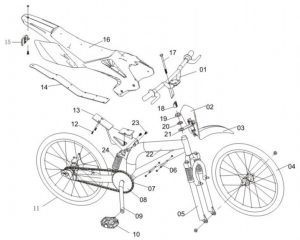
- Handlebar
- Number panel
- Mudguard 4.
- Wheel
- Fork
- Support
- Chain
- Chain wheel
- Crank
- Pedal
- Wheel
- Screw
- Seat Bracket
- Seat Support
- Rear Reflector
- Saddle
- Axle Rod
- Tungsten
- No. 1 Cup
- No. 2 Cup
- Fender Bracket
- Frame
- Locking screws
- Suspension
SAFETY EQUIPMENT
WARNING: Many states require specific safety devices. It is your responsibility to familiarize yourself with the laws of the state where you ride and to comply with all applicable laws, including properly equipping yourself and your bike as the law requires.
- HELMETWhile not all states require bicyclists to wear approved protective headgear, common sense dictates that you should wear an ANSI or Snelll approved helmet whether the requires it or not. Most serious bicycle injuries involve head injuries which might have been avoided if the rider had worn a helmet. Your dealer has a variety of attractive helmets, and can recommend one to suit your needs. Your helmet must fit correctly, be worn correctly and be properly secured to do its real job. Ask your dealer to help you with the fitand adjustment of your helmet.
 WARNING: Always wear a helmet when riding your bike. Always keep the chin strap securely buckled. Failure to wear an approved helmet may result in serious injury or death.
WARNING: Always wear a helmet when riding your bike. Always keep the chin strap securely buckled. Failure to wear an approved helmet may result in serious injury or death. - REFLECTORSReflectors are important safety devices which are designed as an integral part of your bicycle. Federal regulations require every bicycle to be equipped with front, rear, wheel and pedal reflectors. The size, performance and location of each reflector is specified by the U.S. Consumer Products Safety Commission. The reflectors are designed to pick up and reflect car lights in a way that helps you to be seen and recognized as a moving bicyclist.CAUTION: Check reflectors and their mounting brackets regularly to make sure that they are clean, straight, unbroken and securely mounted. Have your dealer replace damaged reflectors and straighten or tighten any that are bent or loose.WARNING: Do not remove the reflectors or reflector mounting brackets from your bicycle. They are an integral part of the bicycles safety system.Being struck by other vehicles often results in serious injury or death. Remember: reflectors are not a substitute for lights. Always equip your bicycle with all state and locally mandated lights.
- LIGHTSWe strongly recommend that children not ride after dusk or before daylight. If you must ride your bike after dusk or before full daylight, your bicycle must be equipped with lights so that you can see the road and avoid road hazards; and so that others can see you. Vehicle laws treat bicycles like any other vehicle. That means you must have a white front and a red rear light operating if you are riding after dusk or before full daylight. Your bike dealer can recommend a battery or generator powered lighting system appropriate to your needs.WARNING: Reflectors are not a substitute for proper lights. It is your responsibility to equip your bicycle with all state and locally mandated lights. Riding at dawn, at dusk, at night or at other times of poor visibility without a bicycle lightning system which meets local and state laws and without reflectors is dangerous and may result in serious injury or death.
- PEDALSSome higher performance model bicycles come equipped with pedals that have sharp and potentially dangerous surfaces. These surfaces are designed to add safety by increasing adhesion between the rider’s shoe and the bicycle pedal. If your bicycle has this type of high-performance pedal, you must take extra care to avoid serious injury from the pedals sharp surfaces.Based on your riding style or skill level, you may prefer a less aggressive pedal design. Your dealer can show you a number of options and make suitable recommendations.
MECHANICAL SAFETY CHECK
Here is a simple, sixty-second mechanical safety check which you should get in the habit of making every time you’re about to get on the bike.
- NUTS, BOLTSLift the front wheel off the ground by two or three inches, then let it bounce on the ground. Anything sound, feel or look loose? Do a quick visual and tactile inspection of the whole bike. Any loose parts or accessories? If so, secure them. If you’re not sure, ask someone with experience to check.
- TIRES & WHEELSTires correctly inflated? Check by putting one hand on the saddle, one on the intersection of the handlebars and stem, then bouncing your weight on the bike while looking at tire deflection. Compare what you see with how it looks when you know the tires are correctly inflated; and adjust if necessary.Tires in good shape? Spin each wheel slowly and look for cuts in the tread and sidewall. Replace damaged tires before riding the bike.Wheels true? Spin each wheel and check for brake clearance and side-to-side wobble. If a wheel wobbles side to side or hits the brake pads, take the bike to a qualified bike shop to have the wheel trued.CAUTION: Wheels must be true for hand brakes to work effectively. Wheel truing is a skill which requires special tools and experience. Do not attempt to true a wheel unless you have the knowledge and tools needed to do the job correctly.
- BRAKESIf your bicycle has hand-operated brakes, squeeze the brake levers. Are the brake shoes contacting the wheel rim within an inch of brake lever movement? Can you apply full braking force at the levers without having them touch the handlebar? If not, your brakes need adjustment. Do not ride the bike until the brakes are properly adjusted. If your bicycle has a coaster brake, check to make sure that the coaster brake arm is securely clamped to the bicycle frame. If the arm or its mounting bracket are loose, do not ride the bike until the brake arm is properly secured.WARNING: Riding with improperly adjusted and secured brakes or worn brake shoes is dangerous and can result in serious injury or death.
- WHEEL NUTSAre the front and rear wheels straight and secure in the dropouts? Are the wheel nuts properly tightened?WARNING: Riding with an improperly installed or insufficiently tightened wheel can cause the wheel to wobble or disengage from the bicycle, which can cause damage to the bicycle and serious injury or death.
- HANDLEBAR AND SADDLE ALIGNMENTAre the saddle and handlebar stem correctly parallel to the bikes top tube and tight enough so that you can twist them out of alignment?6.
- HANDLEBAR ENDSAre the handlebar grips secure and in good condition? If not, replace them. Are the handlebar ends plugged? If not, plug them before you ride.WARNING: Loose or damaged handlebar grips can cause you to lose control and fall. Unplugged handlebars can act like a cookie cutter on your body, and cause serious injury in an otherwise minor accident.
RIDING SAFETY AND RESPONSIBILITY
NOTE: Like any sport, bicycling involves risk of injury and damage. By choosing to ride a bicycle, you assume the responsibility for that risk. Not the people who sold you the bike. Not the people who made it. Not the people who distribute it. Not the people who manage or maintain the roads or trails you ride on. You. So you need to know and to practice the rules of safe and responsible riding.
THE OWNER’S RESPONSIBILITY
WARNING: This bicycle is made to be ridden by one rider at a time for general transportation and recreational use. It is not made to withstand the abuse of stunting and jumping.If the bicycle was purchased unassembled, it is the owner’s responsibility to follow all assembly and adjustment instructions exactly as written in this manual and any “Special Instructions” supplied with the bicycle. The owner must make sure all components are securely attached.If the bicycle was purchased assembled, it’s the owner’s responsibility, before riding the bicycle for the first time, to make sure the bicycle is assembled and adjusted exactly as written in this manual and any “Special Instructions” supplied with the bicycle. The owner must make sure all components are securely attached.This bicycle has a fixed seating position.To determine the correct size of bicycle for the rider:Straddle the assembled bicycle with feet shoulder width apart and flat on the ground.There must be at least one inch of clearance (1) between the highest part of the top tube (2) and the crotch of the rider.The minimum leg-length for the rider is the highest part of the top tube plus one-inch (3).The rider must be able to easily reach and operate the brake levers (if so equipped).
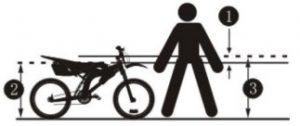
AN IMPORTANT NOTE TO PARENTS
In addition to The Basics, the Rules of the Road, the Rules of the Trail, Wet Weather Riding, Night Riding and Bicycling in Traffic, kids need to be taught … and to have frequently reinforced … the following rules and lessons which adults are already expected to know. We urge you to take the time to familiarize yourself with these rules and to teach them to your child before you let your child ride unsupervised.
- RULES
- No playing in the road or in the street,
- No riding on busy streets.
- No riding at night.
- Stop for all STOP signs.
- Ride on the right of traffic.
- LESSONS
The lessons that follow relate to some of the most common real situations that children encounter when riding their bikes. Go over these situations with your child and make sure the lesson objective is accomplished.Driveway Rideout: When a youngster rides out of the driveway and is struck by a car, that is called a rideout accident.
What can you do?First, realize the danger of your own driveway. If there are obstructions to the view of passing motorists (like bushes or trees), trim them back. You might park your car in front of the driveway, if local ordinance permits. This way, your child can’t use the driveway as a launching pad. But the most important thing you can do is teach your child about driveway safety. Take your child outside to the driveway and have him/her practice the following steps:
- Stop before entering the street.
- Look left, right and left again for traffic.
- If there is no traffic, proceed into the roadway.
Running the Stop Sign: Car/bike crashes can happen when a cyclist runs a stop sign. Most cyclists who get hit riding through stop signs know that they were supposed to stop. They just thought it would be OK this time; or they may have been distracted.The thing to impress upon your child is that while he/she may not get hit every time, running stop signs will eventually result in an accident.
What can you do?Take your child to a stop sign near home. Explain what it means by emphasizing the following points:
- Stop at all stop signs, regardless of what is happening.
- Look in all directions for traffic.
- Watch for oncoming cars making left turns.
- Watch for cars behind you making right turns.
- Wait for any cross traffic to clear.
- Proceed when safe.
In order to make this lesson stick, you may have to change your own driving habits. If you creep through intersections controlled by stop signs, you are showing your child that you don’t really believe what you preach. For your child’s sake, stop at stop signs.Turning Without Warning: Another major accident type involves cyclists who make unexpected left turns. They neither look behind for traffic, nor do they signal. The key factor here is neglecting to look to the rear: If the cyclist had looked, he/she would have seen the danger coming up from behind.
What can you do?Of course, you ought to teach your child not to ride across busy streets at least until the child has had some advanced training and is old enough to understand traffic. But in the meantime, for residential street riding, you can teach your child to always look and signal before turning left. A big part of this lesson is teaching the child how to look to the rear without swerving.Take your child to a playground to practice riding along a straight line while looking behind. Stand alongside and hold up a different number of fingers on your hand after the child rides by. Call his/her name. After 15 minutes of practice, a ten-year-old should be able to look behind his/herself and identify how many fingers you are holding up without swerving.Night Time Riding: Most car/bicycle accidents happen at night where an overtaking car hits a bike. (An overtaking car is one that comes up from behind and passes the cyclist on the left.) These overtaking accidents can be very serious.
What can you do?First, you should keep your youngster from riding at night. It requires special skills and equipment. Few children have either. Secondly, make sure your child understands that if he/she gets caught out after dark on a bike, the thing to do is to call you for a ride home. One suggestion is to tape phone money to the bike so that, in an emergency, the child will be able to call home.Following the Leader: There is increased risk of car/bike collision if children are following each other, because if the first one does something dangerous, those following may do it too.
What can you do?Teach your child to always assess the traffic situation for him/herself. When a group is riding around, each cyclist should stop for stop signs; each cyclist should look to the rear before making left turns; and so on. One way to get the message across is to play a game with the child similar to Simon Says. In this game, however, the emphasis should not be on doing what Simon Says, but rather have the child make a decision based on the situation. The child should learn to ignore what Simon Says. Children need to learn to think for themselves to ride safely.SUMMARY: Teach your child early the earlier the better. Learning skills such as looking and avoiding hazards takes time. Be prepared to repeat lessons until your child understands what you’re trying to get across. Be patient. Your efforts will be rewarded, knowing that your child is aware of safe riding skills.
THE BASICS
- Always do the Mechanical Safety Check before you get on a bike.
- Be thoroughly familiar with the controls of your bicycle.
- Be careful to keep body parts and other objects away from the sharp teeth of chainrings; the moving chain; the turning pedals and cranks; and the spinning wheels of your bicycle.
- Always wear a cycling helmet which meets the latest Snell or ANSI standard.
- Always wear shoes that will stay on your feet and will grip the pedals. Never ride barefoot or wearing sandals.
- Wear bright, visible clothing that is not so loose that it can catch on moving parts of the bicycle or be snagged by objects at the side of the road or trail.
- Don’t jump with your bike. Jumping a bike, particularly a BMX bike, can be fun; but it puts incredible stress on everything from your spokes to your pedals. Perhaps most vulnerable to jumping on jumping their bikes risk serious damage, to their bicycles as well as to themselves.
RULES OF THE ROAD
- Learn the local bicycle laws and regulations. Many communities have special regulations about licensing of bicycles, riding on sidewalks, law regulating bike path and trail use, and so on. Many states have helmet laws, child carrier laws and special bicycle traffic laws. In the U.S. and in most foreign countries, a bicyclist is required to obey the same traffic laws as the driver of a car or motorcycle. It’s your responsibility to know and obey the laws.
- You are sharing the road or the path with others motorists, pedestrians and other cyclists. Respect their rights, and be tolerant if they infringe on yours.
- Ride defensively. Assume that the people with whom you are sharing the road are so absorbed with wat they are doing and where they are going that they are oblivious to you.
- Look ahead of where you’re going, and be ready to avoid:
- Vehicles slowing or turning in front of you, entering the road or your lane ahead of you, or coming up behind.
- Parked car doors opening in front of you.
- Pedestrians stepping out in front of you.
- Children playing near the road.
- Pot holes, sewer grating, railroad tracks, expansions joints, road or sidewalk construction, debris and other obstructions that could cause you to swerve into traffic, catch your wheel or otherwise cause you to lose control and have an accident.
- The many hazards and distractions which can occur on a bicycle.
- Ride in designated bike lanes, on designated bike paths or on the right side of the road, in the same direction as car traffic and as close to the edge of the road as possible.
- Stop at stop signs and traffic lights; slow down and look both ways at street intersections. Remember that a bicycle always loses in collision with a motor vehicle, so be prepared to yield even if you have the right of way.
- Use hand signals for turning and stopping. Learn the local vehicle code for the correct signals.
- Never ride with headphones. They mask traffic sounds and emergency vehicle sirens, distract you from concentrating on what going on around you, and their wires can tangle in the moving parts of the bicycle, causing you to lose control.
- Never carry a passenger.
- Never carry anything which obstructs your vision or your complete control of the bicycle, or which could become entangled in the moving parts of the bicycle.
- Never hitch a ride by holding on to another vehicle.
- Don’t do stunts, wheelies or jumps. They can cause you injury and damage your bike.
- Don’t weave through traffic or make any moves that may surprise people with whom you are sharing the road.
- Observe and yield the right of way.
- Never ride your bicycle while under the influence of alcohol or drugs.
- If possible, avoid riding in bad weather, when visibility is obscured, at dusk or in the dark, or when extremely tired. Each of these conditions increases the risk of accident.
RULES OF THE TRAIL
- We recommend that children not ride off-road without the accompaniment of an adult. In any event, never ride alone in remote areas. Even when riding with others, make sure that someone knows where you’re going and when you expect to be back. Always take along some kind of identification, so that people know who you are in case of an accident; and take a couple of dollars in cash for a candy bar, a cool drink or an emergency phone call.
- Surface hazards make off-road riding much more difficult and therefore more dangerous than riding on paved roads. Start slowly and build up your skills on easier terrain before tackling the more difficult.
- Learn and obey the local laws regulating where and how you can ride off-road, and respect private property. Don’t ride where you are not welcome or where you are not allowed.
- You are sharing the trail with others – hikers, equestrians, other cyclists. Respect their rights, and be tolerant if they inconvenience you.
- Yield right of way to pedestrians and animals. Ride in a way that does not frighten or endanger them, and stay far enough away so that their unexpected moves don’t endanger you.
- You may be riding in sensitive habitat, so stay on the designated trail. Don’t contribute to erosion by riding in mud or with unnecessary sliding. Don’t disturb wildlife or livestock; and don’t disturb the ecosystem by cutting your own trail through vegetation or streams.
- It is your responsibility to minimize your impact on the environment. Ride accordingly. Leave things as you found them; and always take out everything you brought in.
- If you crash: First, check yourself for injuries, and take care of them as best you can. Next, check your bike for damage, and fix what you can. Then, when you get home, carefully perform the maintenance procedure described this manual and check for any other damaged parts. All bent, scored or discolored parts are suspect and should be replaced.
WARNING: A crash can put extraordinary stress on bicycle components, causing them to fatigue prematurely. Components suffering from stress fatigue can fail suddenly and catastrophically, causing loss of control, serious injury or death.CAUTION: If you have any doubt about the condition of the bicycle or any of its parts, take it to your dealer for a thorough check.
WET WEATHER RIDING
WARNING: Wet weather impairs traction, braking and visibility, both for the bicyclist and for other vehicles sharing the road. The risk of accident is dramatically increased in wet conditions.Under wet conditions, the stopping power of your brakes (as well as the brakes of other vehicles sharing the road) is dramatically reduced and your tires don’t grip nearly as well. This makes it harder to control speed and easier to lose control. To make sure that you can slow down and stop safely in wet conditions, ride more slowly and apply your brakes earlier and more gradually than you would under normal, dry conditions.
NIGHT RIDING
Riding a bicycle at night is many times more dangerous than riding during the day. Therefore, children should never ride at dawn, at dusk or in the dark. Adults should not ride at dawn, at dusk or at night unless it is absolutely necessary.WARNING: Riding at dawn, at dusk, at night or at other times of poor visibility without a bicycle lighting system which meets local and State laws and without reflectors is dangerous and can result in serious injury or death. Even if you have excellent night vision, many of the people with whom you’re sharing the road don’t. A bicyclist is very difficult for motorists and pedestrians to see at dawn, at dusk, at night or at other times of poor visibility. If you must ride under these conditions, check and be sure you comply with all local laws about night riding: follow the Rules of the Road and of the Trail even more carefully; and make sure to take the following additional precautions:Before riding at dawn, at dusk, at night or at other times of poor visibility, take the following steps to make yourself more visible:
- Make sure that your bicycle is equipped with correctly positioned and securely mounted reflectors.
- Purchase and install an adequate battery or generator powered head and tail light.
- Wear light colored, reflective clothing and accessories, such as a reflective vest, reflective arm and leg bands, reflective stripes on your helmet, flashing lights…any reflective device or light source that moves will help you get the attention of approaching motorists, pedestrians and other traffic.
- Make sure your clothing or anything you may be carrying on the bicycle does not obstruct a reflector or light.While riding at dawn, at dusk, at night or at other times of poor visibility:
- Ride slowly.
- Avoid areas of heavy traffic, dark areas, and roads with speed limits over 35mph.
- Avoid road hazards.
- If possible, ride on routes already familiar to you.
BICYCLING IN TRAFFIC
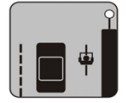 |
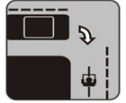 |
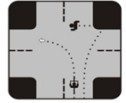 |
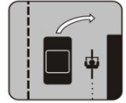 |
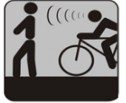 |
| Obey traffic signs and signals – bicycles must drive like any other vehicles if they are to be taken seriously by the motorists. | Never ride against traffic – motorists aren’t looking for bicyclists on the wrong side of the road. | Choose best way to turn left – there are two ways to make left turn. 1. Like a car – signal, move into the left lane and turn left. 2. Like a pedestrian – ride straight to the far side crosswalk. Walks your bike across. | Don’t pass on the right – motorists may not look for o see a bicycle passing on the right. | Go slow on sidewalks – pedestrians have the right of way. By law, you must give pedestrians audible warning when you pass. Don’t cross driveways or intersections without slowing to a walker’s pace and looking very carefully for traffic (especially traffic turning right on a green light). |
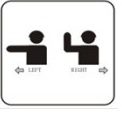 |
 |
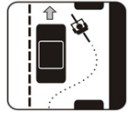 |
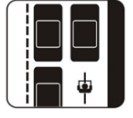 |
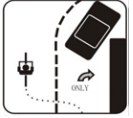 |
| Use hand signals – hand signals, using your left arm, tell motorists what you intend to do. Signal as a matter of law, courtesy and safety. | Ride in a straight line – whenever possible, ride in a straight line, to the right of traffic, but about a car doors width away from parked cars. | Don’t weave between parked cars – don’t ride out to the curb between parked cars unless they are far apart. Motorists may not see you when you try to move back into traffic. | Ride in middle of lane in slow traffic – get in the middle of the lane at busy intersections and whenever you are moving at the same speed as traffic. | Follow lane markings – don’t turn left from right lane. Don’t go straight in a lane marked Right Turn Only. |
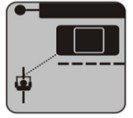 |
 |
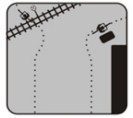 |
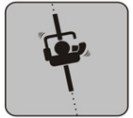 |
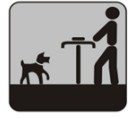 |
| Watch for cars pulling out – make eye contact with driver. Assume they don’t see you until you are sure they do. | Scan the road behind – learn to look back over your shoulder without losing your balance or swerving left. Some riders use rear view mirrors. | Avoid road hazards – watch out for parallel slat sewer grates, slippery manhole cover, oily pavement, gravel and ice. Cross railroad tracks carefully at right angles. To get better control as you move across bumps and other hazards, stand up on your pedals. | Keep both hands ready to brake – you may not stop in time if you brake onehanded. Allow extra distance for stopping in the rain, since brakes are less efficient when wet. | Watch for chasing dogs – ignore them or try a firm No! if the dog doesn’t stop, dismount with your bike between you and the dog. Dogs are attracted to spinning wheels and feet. |
ASSEMBLY, MAINTENANCE AND ADJUSTMENT
ASSEMBLY STEPS
- Put the front wheel in the center of the fork; tighten the nuts to the axle with the wrench provided.

- Insert and tighten the screws provided securely on the seat bracket with the Allen wrench.

- Slide out the two head parts, then put the fender on the front fork stem, then return and tighten them with the wrench provided.

- Arrange the handlebar upright and centered in the fork stem with the screw and wrench provided.

- Insert the four seat stands into the down tube.

- Place the seat on seat support and tighten the seat with the screws and nuts and the wrench provided.

- Thread the pedal marked R clockwise into the right chain wheel side of the crank arm with the wrench provided. The same to leftpedal.

- Align hole in rear reflector bracket with hole in rear fender. Position screw into holes and secure tightly.


TIRES
TIRE VALVESThe tire valve allows air to enter the tire’s inner tube under pressure, but doesn’t let it back out unless you want it to. There are primarily two kinds of bicycle tube valves (actually, there are other designs, but they are seldom seen in the US anymore): The Schraeder Valve and the Presta Valve. The bicycle pump you use must have the fitting appropriate to the valve stems on your bicycle.
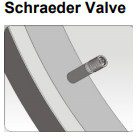
The Schraeder (Shown) is like the valve on a car tire. To inflate a Schroeder valve tube, just remove the valve cap and push the air hose or pump fitting onto the end of the valve stem. To let air out of a Schraeder valve, depress the pin in the end of the valve stem with the end of a key or other appropriate object.

The Presta (Shown) has a narrower diameter and is only found on bicycle tires. To inflate a Presta valve tube using a Presta headed bicycle pump, remove the valve cap; unscrew (counterclockwise) the valve stem lock nut; and push down on the valve stem to free it up. Then push the pump head on to the valve head, and inflate. To inflate a Presta valve with a gas station air hose, you’ll need a Presta adapter (available at your bike shop) which screws on to the valve stem once you’ve freed up the valve. The adapter fits the end of the air hose fitting. To let air out of a Presta valve, open up the valve stem lock nut and depress the valve stem. Always close the valve stem lock after inflation.
TIRE REMOVAL
- Let the air out of the tire by depressing the valve core (the little pin in the centre of the valve stem opening).
- Separate the tire bead from the sides of the rim by pressing with your thumbs. Work your way around the tire on both sides to be sure that the beads of the tire are not sticking to the rim. (Figure A)
- Stand the wheel up on a firm surface with the valve stem on the bottom and grasp the upper part of the tire with both hands. Try to roll the tire off the far side of the rim.
- With the wheel standing as in Figure 3, use bicycle tire tools or spoon handles with rounded ends (at least two preferably three) to lift the bead on one side of the tire off the rim. Be careful not to pinch the inner tube between the tire tools and the tire bead or rim. Once you have got the bead off for about one fourth of the circumference of the tire using the tools, the rest can usually be pulled off by hand.
- With the bead on one side of the tire completely off the rim, you can now pull the inner tube out from between the tire and rim everywhere except in the area of the valve stem.
- It should now be easy to pull the tire the rest of the way off the rim. Start at the side of the wheel opposite the valve stem and simply lift the bead of the tire up over the side of the rim and pull it off.Figure A: Press with thumbs to separate the bead. Continue around entire rim until the bead is completely separated.
 Figure B: Lift bead with spoons or tire tools.
Figure B: Lift bead with spoons or tire tools. Figure C: Replace tire onto rim.
Figure C: Replace tire onto rim.
 Figure D: Rim strip protects inner tube from spoke ends.
Figure D: Rim strip protects inner tube from spoke ends.
Figure F: Use thumbs valve stem through hole in rim. Make certain valve stem is straight.

REPAIR AND SERVICE
WARNING: Inspect the bicycle frequently. Failure to inspect the bicycle and to make repairs or adjustments, as necessary can result in injury to the rider or to others. Make sure all parts are correctly assembled and adjusted as written in this manual and any “Special Instructions”.
Immediately replace any damaged, missing, or badly worn parts.Make sure all fasteners are correctly tightened as written in this manual and any “Special Instructions”. Parts that are not tight enough can be lost or operate poorly. Overtightened parts can be damaged. Make sure any replacement fasteners are the correct size and type.If your frame is aluminum, inspect the bicycle frame carefully and frequently. Aluminum frames can develop very small cracks due to stress, severe shocks, etc. If you see any small cracks, stop riding the bicycle. Have the frame inspected by a qualified professional at a bicycle service shop before riding the bicycle again.NOTE: Have a bicycle service shop make any repairs or adjustments for which you do not have the correct tools or if the instructions in this manual or any “Special Instructions” are not sufficient for you.
REAR WHEEL/CHAIN ADJUSTMENT
Maintenance:The chain must be at the correct tightness. If too tight, the bicycle will be difficult to pedal. If too loose, the chain can come off the sprockets.WARNING: The chain must remain on the sprockets. If the chain comes off the sprockets, the coaster brake will not operate.When the chain (1) is at the correct tightness, you can pull it one-half inch (2) away from a straightedge (3) as shown.

TIRES
Maintenance:Frequently check the tire inflation pressure because all tires lose air slowly over time. For extended storage, keep the weight of the bicycle off the tires.WARNING: Do not ride or sit on the bicycle if either inner tube is under inflated. This can damage the tire and inner tube. Do not use unregulated air hoses to innate the inner tubes. An unregulated hose can suddenly over innate bicycle tires and cause them to burst.Use a hand or a foot pump to inflate the inner tubes. Service station meter-regulated air hoses are also acceptable. The correct inflation pressure is shown on the tire sidewall.Before adding air to any tire, make sure the edge of the tire (the bead) is the same distance from the rim, all around the rim, on both sides of the tire. If the tire does not appear to be seated correctly, release air from the inner tube until you can push the bead of the tire into the rim where necessary. Add air slowly and stop frequently to check the tire sealing and the pressure, until you reach the correct inflation pressure as indicated on the tire sidewall. Replace worn or defective tires and inner tubes.
WHEELS
Wheel InspectionIt is most important that wheels are kept in top condition. Properly maintaining your bicycle’s wheels will help braking performance and stability when riding. Be aware of the following potential problems:
- Dirty or greasy rims:Caution: These can render your brakes ineffective. Do not clean them with oily or greasy materials. When cleaning, use a clean rage or wash with soapy water, rinse and air dry. Don’t ride while they’re wet. When lubricating your bicycle, don’t get oil on the rim braking surfaces.
- Wheels not straight:Lift each wheel off the ground and spin them to see if they are crooked or out of round. If wheels are not straight, they will need to be adjusted. This is quite difficult and is best left to a bicycle specialist.
- Broken or loose spokes:Check that all spokes are tight and that none are missing or damaged.Caution: Such damage can result in severe instability and possibly an accident if not corrected. Again, bicycle specialist best handles spoke repairs.
- Loose hub bearings:Lift each wheel off the ground and try to move the wheel from side to side. Caution: If there is movement between the axle and the hub, do not ride the bicycle. Adjustment is required. Axle nuts: Check that these are tight before each ride.
INSPECTION OF BEARINGS
Maintenance:Frequently check the bearings of the bicycle. Have a bicycle service shop lubricate the bearings once a year or any time they do not pass the following tests.Head Tube Bearings:The fork should turn freely and smoothly at all times. With the front wheel off the ground, you should not be able to move the fork up, down, or side-to-side in the head tube.Crank Bearings:The crank should turn freely and smoothly at all times and the front sprockets should not be loose on the crank. You should not be able to move the pedal end of the crank from side-toside.Wheel Bearings:Lift each end of the bicycle off the ground and slowly spin the raised wheel by hand. The bearings are correctly adjusted if:The wheel spins freely and easily. The weight of the spoke reflector, when you put it toward the front or rear of the bicycle, causes the wheel to spin back and forth several times. There is no side-to-side movement at the wheel rim when you push it to the side with light force.
LUBRICATION / MAINTENANCE
WARNING: Do not over lubricate. If oil gets on the wheel rims or the brake shoes, it will reduce brake performance and a longer distance to stop the bicycle will be necessary. Injury to the rider or to others can occur.
The chain can throw excess oil onto the wheel rim. Wipe excess oil off the chain. Keep all oil off the surfaces of the pedals where your feet rest.
Using soap and hot water, wash all oil off the wheel rims, the brake shoes, the pedals, and the tires. Rinse with clean water and dry completely before you ride the bicycle. Using a light machine oil (20W) and the following guidelines, lubricate the bicycle:
| WHAT | WHEN | HOW |
| Brake levers | every six months | Put one drop of oil on the pivot point of each brake lever |
| Caliper Brakes | every six months | Put one drop of oil on the pivot point of each brake lever |
| Brake Cables | every six months | Put four drops of oil into both ends of each cable. Allow the oil to soak back along the cable wire. |
| Pedals | every six months | Put four drops of oil where each pedal axle goes into the pedal. |
| Chain | every six months | Put one drop of oil on each roller of the chain. Wipe all excess oil off the chain |
ONE PIECE CRANKS
To adjust the free play in a one-piece type bottom bracket, loosen the locknut on the left side by turning it clockwise and tighten the adjusting cone counter-clockwise using a screwdriver in the slot. When correctly adjusted, re-tighten the locknut counter-clockwise.
- Remove the chain from the chain wheel.
- Remove the left pedal by turning the spindle clockwise.
- Remove the left side locknut by turning it clockwise and remove the keyed lock washer.
- Remove the adjusting cone by turning it clockwise with a screwdriver.
- Remove the left ball retainer, slide the crank assembly out of the frame to the right and remove the right ball retainer. Clean and inspect all bearing surfaces and ball retainers, and replace any damaged parts. Pack the ball bearings retainers with grease, then re-assemble in the reverse of the above procedure.

TERMS AND CONDITIONS OF WARRANTY, WARRANTY CLAIMS
General Conditions of Warranty and Definition of TermsAll Warranty Conditions stated here under determine Warranty Coverage and Warranty Claim Procedure. Conditions of Warranty and Warranty Claims are governed by Act No. 89/2012 Coll. Civil Code, and Act No. 634/1992 Coll., Consumer Protection, as amended, also in cases that are not specified by these Warranty rules. The seller is SEVEN SPORT s.r.o. with its registered office in Strakonická street 1151/2c, Prague 150 00, Company Registration Number: 26847264, registered in the Trade Register at Regional Court in Prague, Section C, Insert No. 116888. According to valid legal regulations it depends whether the Buyer is the End Customer or not.“The Buyer who is the End Customer” or simply the “End Customer” is the legal entity that does not conclude and execute the Contract in order to run or promote his own trade or business activities. “The Buyer who is not the End Customer” is a Businessman that buys Goods or uses services for the purpose of using the Goods or services for his own business activities. The Buyer conforms to the General Purchase Agreement and business conditions. These Conditions of Warranty and Warranty Claims are an integral part of every Purchase Agreement made between the Seller and the Buyer. All Warranty Conditions are valid and binding, unless otherwise specified in the Purchase Agreement, in the Amendment to this Contract or in another written agreement.
Warranty ConditionsWarranty PeriodThe Seller provides the Buyer a 24 months Warranty for Goods Quality, unless otherwise specified in the Certificate of Warranty, Invoice, Bill of Delivery or other documents related to the Goods. The legal warranty period provided to the Consumer is not affected.By the Warranty for Goods Quality, the Seller guarantees that the delivered Goods shall be, for a certain period of time, suitable for regular or contracted use, and that the Goods shall maintain its regular or contracted features.The Warranty does not cover defects resulting from (if applicable):
- User’s fault, i.e. product damage caused by unqualified repair work, improper assembly, insufficient insertion of seat post into frame, insufficient tightening of pedals and cranks
- Improper maintenance
- Mechanical damages
- Regular use (e.g. wearing out of rubber and plastic parts, moving mechanisms, joints, wear of brake pads/blocks, chain, tires, cassette/multi wheel etc.)
- Unavoidable event, natural disaster
- Adjustments made by unqualified person
- Improper maintenance, improper placement, damages caused by low or high temperature, water, inappropriate pressure, shocks, intentional changes in design or construction etc.
Warranty Claim Procedure
The Buyer is obliged to check the Goods delivered by the Seller immediately after taking the responsibility for the Goods and its damages, i.e. immediately after its delivery. The Buyer must check the Goods so that he discovers all the defects that can be discovered by such check.When making a Warranty Claim the Buyer is obliged, on request of the Seller, to prove the purchase and validity of the claim by the Invoice or Bill of Delivery that includes the product’s serial number, or eventually by the documents without the serial number. If the Buyer does not prove the validity of the Warranty Claim by these documents, the Seller has the right to reject the Warranty Claim.If the Buyer gives notice of a defect that is not covered by the Warranty (e.g. in the case that the Warranty Conditions were not fulfilled or in the case of reporting the defect by mistake etc.), the Seller is eligible to require a compensation for all the costs arising from the repair. The cost shall be calculated according to the valid price list of services and transport costs.If the Seller finds out (by testing) that the product is not damaged, the Warranty Claim is not accepted. The Seller reserves the right to claim a compensation for costs arising from the false Warranty Claim.In case the Buyer makes a claim about the Goods that is legally covered by the Warranty provided by the Seller, the Seller shall fix the reported defects by means of repair or by the exchange of the damaged part or product for a new one. Based on the agreement of the Buyer, the Seller has the right to exchange the defected Goods for a fully compatible Goods of the same or better technical characteristics. The Seller is entitled to choose the form of the Warranty Claim Procedures described in this paragraph.The Seller shall settle the Warranty Claim within 30 days after the delivery of the defective Goods, unless a longer period has been agreed upon. The day when the repaired or exchanged Goods is handed over to the Buyer is considered to be the day of the Warranty Claim settlement. When the Seller is not able to settle the Warranty Claim within the agreed period due to the specific nature of the Goods defect, he and the Buyer shall make an agreement about an alternative solution. In case such agreement is not made, the Seller is obliged to provide the Buyer with a financial compensation in the form of a refund.
CZ SEVEN SPORT s.r.o.
Phone:+420 556 300 970Web: www.inSPORTline.cz
References
[xyz-ips snippet=”download-snippet”]

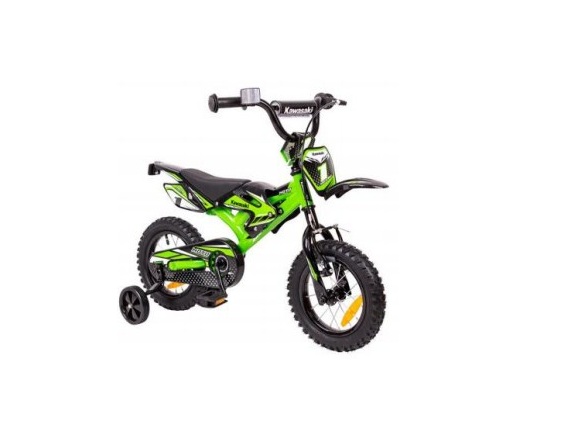
 WARNING: Always wear a helmet when riding your bike. Always keep the chin strap securely buckled. Failure to wear an approved helmet may result in serious injury or death.
WARNING: Always wear a helmet when riding your bike. Always keep the chin strap securely buckled. Failure to wear an approved helmet may result in serious injury or death.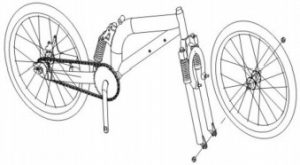
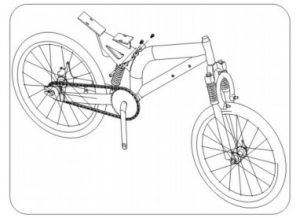
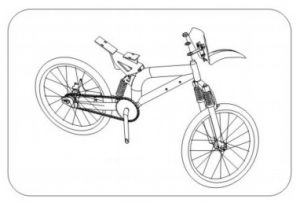
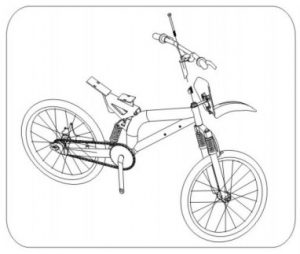
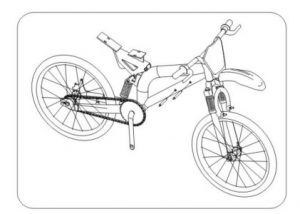
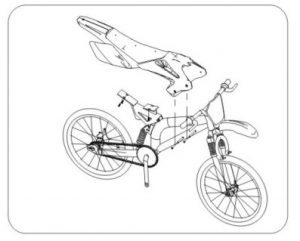
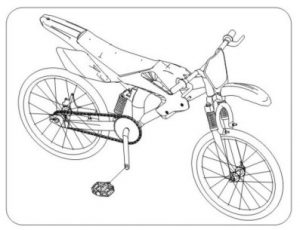
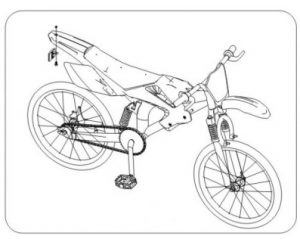
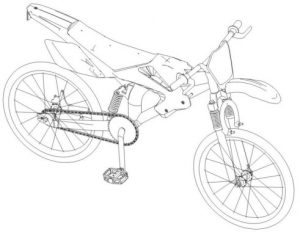
 Figure B: Lift bead with spoons or tire tools.
Figure B: Lift bead with spoons or tire tools. Figure C: Replace tire onto rim.
Figure C: Replace tire onto rim.
 Figure D: Rim strip protects inner tube from spoke ends.
Figure D: Rim strip protects inner tube from spoke ends.

